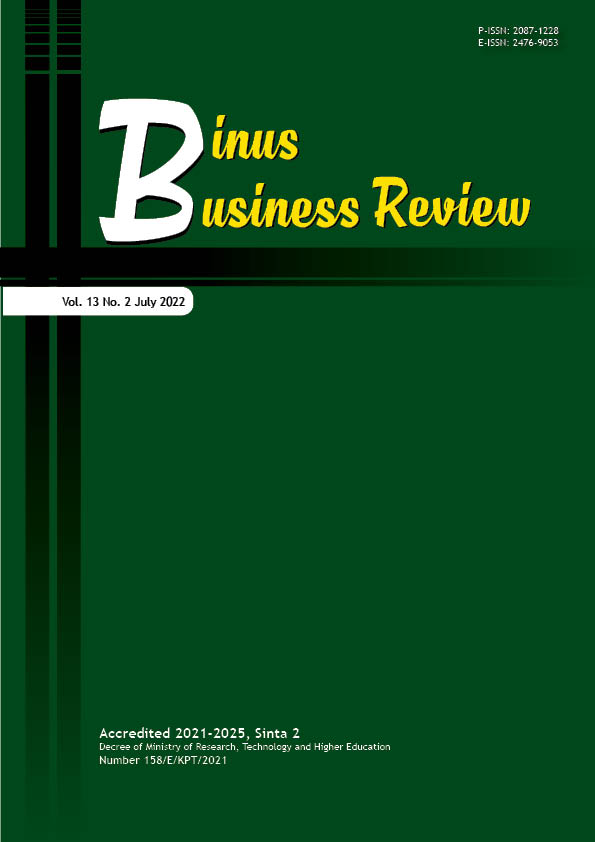Performance Analysis in Palm Oil Industry Using Supply Chain Operations Reference (SCOR) Model
DOI:
https://doi.org/10.21512/bbr.v13i2.8027Keywords:
performance analysis, palm oil industry, Supply Chain Operations Reference (SCOR) modelAbstract
The research aims to map the process and measure supply chain performance in the palm oil industry using the Supply Chain Operation Reference (SCOR) Model 11.0 approach. It was considered that this industry could influence the country’s foreign exchange. The object of research was PT Perkebunan Nusantara I (PTPN I), Aceh. It was chosen because, compared to other PTPNs in the Sumatra region, the lowest productivity rate for palm oil processing was around 2,8 tons/ha, inversely proportional to the land area owned by state plantations of 42.233 ha. Data were collected using field survey methods and interviews with company managers involved in the company chain process. This measurement process was useful for measuring achievements and correcting ineffective supply chain processes. The results show that supply chain performance analysis for performance metrics has not reached the expected target. It describes Perfect Order Fulfillment (POF) with a gap of 98%, Order Fulfillment Cycle Time (OFCT) of 3,93 days, Total Cost to Serve (TCTS) of 71%, Cash to Cash Cycle Time (CCCT) of 242,32 days, and Return on Supply Chain Fixed Assets (ROF) of 0,123 times, when viewed from the calculation of the Lost Opportunity Measurement (LOM). In the research, four recommendations for improvement are given based on the problems that occur in the company using the best practices of the SCOR model. They are manufacturing reliability improvement, batch reduction, Single Minutes Exchange of Dies (SMED), and make-to-order fulfillment strategy.
References
Badan Koordinasi Penanaman Modal. (2017). Perkembangan realisasi investasi PMA dan PMDN menurut sektor industri, Statistik BKPM, 2017. Retrieved from https://nswi.bkpm.go.id/data_statistik
Bolstorff, P., & Rosenbaum, R. (2012). Supply chain excellence: A handbook for dramatic improvement using the SCOR model. New York: American Management Association (AMA).
Badan Pusat Statistik. (2016). Statistik kelapa sawit Indonesia 2016. Retrieved from https://www.bps.go.id/publication/2017/11/10/5c499ba5089da29bba2a148e/statistik-kelapa-sawit-indonesia-2016.html
Camargo, M. E., Zanandrea, G., Pacheco, M. T. M., Malafaia, G. C., & Da Motta, M. E. V. (2013). Supply Chain Management Operations Reference (SCOR): Study bibliometric. International Journal of Operations and Logistics Management, 2(4), 1−13.
Chopra, S., & Meindl, P. (2013). Supply chain management: Strategy, planning, and operations. New Jersey: Pearson Education.
Jakfar, F., Romano, & Nurcholis. (2015). Pengelolaan rantai pasok dan daya saing kelapa sawit di Aceh. AGRARIS: Journal of Agribusiness and Rural Development Research, 1(2), 108−113.
Nurjaman, S. (2013). Pengukuran kinerja dengan metode balanced scorecard. Trikonomika, 12(2), 113−124.
Pacheco, P., Gnych, S., Dermawan, A., Komarudin, H., & Okarda, B. (2017). The palm oil global value chain: Implications for economic growth and socialand environmental sustainability. Center for International Forestry Research.
Paul, J. (2014). Transformasi rantai suplai dengan model SCOR. Jakarta: PT Pustaka Binaman Pressindo (Penerbit PPM).
Pratiwi, A., & Sarjono, H. (2014). Proposed improvement of performance calculation of supply chain management. Applied Mathematical Sciences, 8(97), 4831−4846.
Purba, F. S., Dewi, N., & Maharani, E. (2018). Analisis rantai pasokan tandan buah segar kelapa sawit di PTPN V Sei Pagar Kabupaten Kampar. Jurnal Online Mahasiswa (JOM) Fakultas Pertanian, 5(1), 1−7.
Sarjono, H., Suprapto, A. T., & Megasari, L. (2017). Supply chain performance measurement using SCOR model in the distribution company in Indonesia. In 2017 3rd International Conference on Information Management (ICIM) (pp. 186−189). IEEE.
Sekaran, U., & Bougie, R. (2014). Research methods for business: A skill-building approach. Wiley.
Siahaan, S. H. (2016). Analisis klaster industri dalam perspektif manajemen rantai pasokan perkebunan kelapa sawit di Provinsi Sumatera Utara. Jurnal Ekonomi & Kebijakan Publik, 7(2), 201−213.
Sutopo, W., Maryanie, D. I., & Yuniaristanto, Y. (2015). Evaluation of valuable chain in palm oil industry based on SCOR model: A case study. International Journal of Logistics Systems and Management, 21(2), 229−241.
Wisner, J. D., Tan, K. C., & Leong, K. (2012). Principles of supply chain management: A balanced approach. Cengage Learning.
Yuniaristanto, Ikasari, N., Sutopo, W., & Zakaria, R. (2020). Performance measurement in supply chain using SCOR model in the lithium battery factory. In IOP Conference Series: Materials Science and Engineering (Vol. 943, No. 1). IOP Publishing.
Downloads
Published
How to Cite
Issue
Section
License
Copyright (c) 2022 Haryadi Sarjono, Kevin Christofer, Georgie Florensky Nayoan, Mochamad Derisman Nugraha

This work is licensed under a Creative Commons Attribution-ShareAlike 4.0 International License.
Authors who publish with this journal agree to the following terms:
a. Authors retain copyright and grant the journal right of first publication with the work simultaneously licensed under a Creative Commons Attribution License - Share Alike that allows others to share the work with an acknowledgment of the work's authorship and initial publication in this journal.
b. Authors are able to enter into separate, additional contractual arrangements for the non-exclusive distribution of the journal's published version of the work (e.g., post it to an institutional repository or publish it in a book), with an acknowledgment of its initial publication in this journal.
c. Authors are permitted and encouraged to post their work online (e.g., in institutional repositories or on their website) prior to and during the submission process, as it can lead to productive exchanges, as well as earlier and greater citation of published work.
USER RIGHTS
All articles published Open Access will be immediately and permanently free for everyone to read and download. We are continuously working with our author communities to select the best choice of license options, currently being defined for this journal as follows: Creative Commons Attribution-Share Alike (CC BY-SA)





















